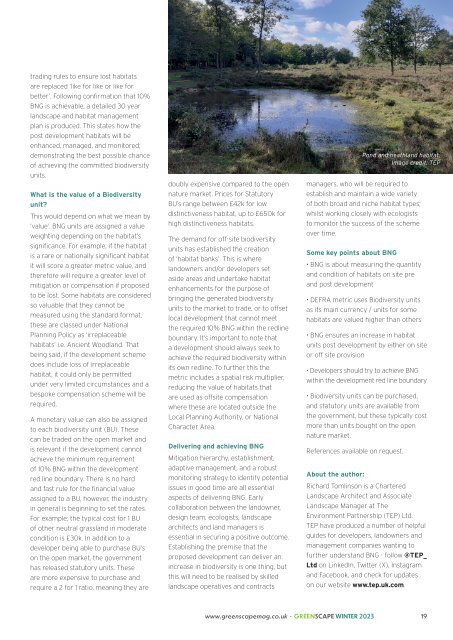Winter 2023
Create successful ePaper yourself
Turn your PDF publications into a flip-book with our unique Google optimized e-Paper software.
trading rules to ensure lost habitats<br />
are replaced ‘like for like or like for<br />
better’. Following confirmation that 10%<br />
BNG is achievable, a detailed 30 year<br />
landscape and habitat management<br />
plan is produced. This states how the<br />
post development habitats will be<br />
enhanced, managed, and monitored;<br />
demonstrating the best possible chance<br />
of achieving the committed biodiversity<br />
units.<br />
What is the value of a Biodiversity<br />
unit?<br />
This would depend on what we mean by<br />
‘value’. BNG units are assigned a value<br />
weighting depending on the habitat’s<br />
significance. For example; if the habitat<br />
is a rare or nationally significant habitat<br />
it will score a greater metric value, and<br />
therefore will require a greater level of<br />
mitigation or compensation if proposed<br />
to be lost. Some habitats are considered<br />
so valuable that they cannot be<br />
measured using the standard format,<br />
these are classed under National<br />
Planning Policy as ‘irreplaceable<br />
habitats’ i.e. Ancient Woodland. That<br />
being said, if the development scheme<br />
does include loss of irreplaceable<br />
habitat, it could only be permitted<br />
under very limited circumstances and a<br />
bespoke compensation scheme will be<br />
required.<br />
A monetary value can also be assigned<br />
to each biodiversity unit (BU). These<br />
can be traded on the open market and<br />
is relevant if the development cannot<br />
achieve the minimum requirement<br />
of 10% BNG within the development<br />
red line boundary. There is no hard<br />
and fast rule for the financial value<br />
assigned to a BU, however, the industry<br />
in general is beginning to set the rates.<br />
For example; the typical cost for 1 BU<br />
of other neutral grassland in moderate<br />
condition is £30k. In addition to a<br />
developer being able to purchase BU’s<br />
on the open market, the government<br />
has released statutory units. These<br />
are more expensive to purchase and<br />
require a 2 for 1 ratio, meaning they are<br />
doubly expensive compared to the open<br />
nature market. Prices for Statutory<br />
BU’s range between £42k for low<br />
distinctiveness habitat, up to £650k for<br />
high distinctiveness habitats.<br />
The demand for off-site biodiversity<br />
units has established the creation<br />
of ‘habitat banks’. This is where<br />
landowners and/or developers set<br />
aside areas and undertake habitat<br />
enhancements for the purpose of<br />
bringing the generated biodiversity<br />
units to the market to trade, or to offset<br />
local development that cannot meet<br />
the required 10% BNG within the redline<br />
boundary. It’s important to note that<br />
a development should always seek to<br />
achieve the required biodiversity within<br />
its own redline. To further this the<br />
metric includes a spatial risk multiplier,<br />
reducing the value of habitats that<br />
are used as offsite compensation<br />
where these are located outside the<br />
Local Planning Authority, or National<br />
Character Area.<br />
Delivering and achieving BNG<br />
Mitigation hierarchy, establishment,<br />
adaptive management, and a robust<br />
monitoring strategy to identify potential<br />
issues in good time are all essential<br />
aspects of delivering BNG. Early<br />
collaboration between the landowner,<br />
design team, ecologists, landscape<br />
architects and land managers is<br />
essential in securing a positive outcome.<br />
Establishing the premise that the<br />
proposed development can deliver an<br />
increase in biodiversity is one thing, but<br />
this will need to be realised by skilled<br />
landscape operatives and contracts<br />
managers, who will be required to<br />
establish and maintain a wide variety<br />
of both broad and niche habitat types;<br />
whilst working closely with ecologists<br />
to monitor the success of the scheme<br />
over time.<br />
Some key points about BNG<br />
• BNG is about measuring the quantity<br />
and condition of habitats on site pre<br />
and post development<br />
• DEFRA metric uses Biodiversity units<br />
as its main currency / units for some<br />
habitats are valued higher than others<br />
• BNG ensures an increase in habitat<br />
units post development by either on site<br />
or off site provision<br />
• Developers should try to achieve BNG<br />
within the development red line boundary<br />
• Biodiversity units can be purchased,<br />
and statutory units are available from<br />
the government, but these typically cost<br />
more than units bought on the open<br />
nature market.<br />
References available on request.<br />
About the author:<br />
Pond and heathland habitat.<br />
Image credit: TEP<br />
Richard Tomlinson is a Chartered<br />
Landscape Architect and Associate<br />
Landscape Manager at The<br />
Environment Partnership (TEP) Ltd.<br />
TEP have produced a number of helpful<br />
guides for developers, landowners and<br />
management companies wanting to<br />
further understand BNG - follow @TEP_<br />
Ltd on LinkedIn, Twitter (X), Instagram<br />
and Facebook, and check for updates<br />
on our website www.tep.uk.com.<br />
www.greenscapemag.co.uk • GREENSCAPE WINTER <strong>2023</strong> 19

















